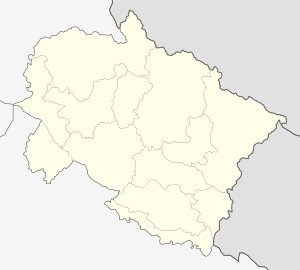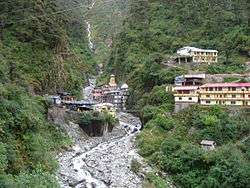Gangotri
| Gangotri | |
|---|---|
| city | |
|
Gangotri | |
 Gangotri  Gangotri Location in Uttarakhand, India | |
| Coordinates: 30°59′N 78°56′E / 30.98°N 78.93°ECoordinates: 30°59′N 78°56′E / 30.98°N 78.93°E | |
| Country | India |
| State | Uttarakhand |
| District | Uttarkashi |
| Elevation | 3,415 m (11,204 ft) |
| Population (2001) | |
| • Total | 606 |
| Languages | |
| • Official | Hindi |
| Time zone | IST (UTC+5:30) |
| Vehicle registration | UK |
| Website |
uk |
Gangotri (Hindi: गंगोत्री) is a town and a Nagar Panchayat (municipality) in Uttarkashi district in the state of Uttarakhand, India. It is a Hindu pilgrim town on the banks of the river Bhagirathi and origin of River Ganges. It is on the Greater Himalayan Range, at a height of 3,100 metres (10,200 ft). According to popular Hindu legend, it was here that Goddess Ganga descended when Lord Shiva released the mighty river from the locks of his hair.
Geography
Gangotri is located at 30°59′N 78°56′E / 30.98°N 78.93°E.[1]
Gangotri Temple
Gangotri, the origin of the River Ganges and seat of the goddess Ganga, is one of the four sites in the Chota Char Dham pilgrimage circuit. The original Gangotri Temple was built by the Gurkha general Amar Singh Thapa. The river is called Bhagirathi at the source and acquires the name Ganga (the Ganges) from Devprayag onwards where it meets the Alaknanda. The origin of the holy river is at Gaumukh, set in the Gangotri Glacier, and is a 19 km trek from Gangotri.
Places to visit near the Gangotri Temple
- Bhagirath Shila is believed to be the holy rock where King Bhagirath prayed to Lord Shiva.
- Pandava Gufa, located 1.5 km from Gangotri, is the place where the Pandavas are believed to have meditated and rested en route Kailash. Pilgrims will have to trek up to the Pandava Gufa.
In the pilgrimage journey of Chota Char Dham, Gangotri is often visited after Yamunotri (located on the western region of Garhwal Hills). Pilgrims generally make Uttarkashi as their base camp. The time taken from Uttarkashi to Gangotri temple is about 4 hours by road.
 Gangotri temple
Gangotri temple.jpg) Gaumukh, source of the Ganges above Gangotri
Gaumukh, source of the Ganges above Gangotri
Historical relation
According to Hindu history, Goddess Ganga took the form of a river to absolve the sins of King Bhagiratha's predecessors, following his severe penance of several centuries.
Submerged Shivlingam
According to this legend, King Sagara, after slaying the demons on earth decided to stage an Ashwamedha Yajna as a proclamation of his supremacy. The horse which was to be taken on an uninterrupted journey around the earth was to be accompanied by the King's 60,000 sons born to Queen Sumati and one son Asamanja born of the second queen Kesani. Indra, supreme ruler of the gods feared that he might be deprived of his celestial throne if the "Yajna" (worship with fire) succeeded and then took away the horse and tied it to the ashram of Sage Kapil, who was then in deep meditation. The sons of the King Sagara searched for the horse and finally found it tied near the meditating sage. Sixty thousand angry sons of King Sagara stormed the ashram of sage Kapil. When he opened his eyes, the 60,000 sons had all perished, by the curse of sage Kapil. Bhagiratha, the grandson of King Sagar, is believed to have meditated to please the Goddess Ganga enough to cleanse the ashes of his ancestors, and liberate their souls, granting them salvation or Moksha.
Demographics
As of 2001 India census,[2] Gangotri had a population of 606. Males constitute 60% of the population and females 40%. Gangotri has an average literacy rate of 89%, male literacy is 91%, female literacy is 80%. In Gangotri, average age of the population is under 6 years of age.
See also
References
- ↑ "Maps, Weather, and Airports for Gangotri, India". fallingrain.com.
- ↑ "Census of India 2001: Data from the 2001 Census, including cities, villages and towns (Provisional)". Census Commission of India. Archived from the original on 2004-06-16. Retrieved 2008-11-01.
External links
| Wikimedia Commons has media related to Gangotri. |

